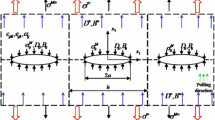Abstract
Magnetoelectroelastic materials are inherently brittle and prone to fracture. Therefore, it is important to evaluate the fracture behavior of these advanced materials. In this paper, a periodic array of cracks in a transversely isotropic magnetoelectroelastic material is investigated. Hankel transform is applied to solve elastic displacements, electric potential and magnetic potential. The problem is reduced into a system of integral equations. Both impermeable and permeable crack-face electromagnetic boundary conditions assumptions are investigated. Quantities of the stress, electric displacement and magnetic induction and their intensity factor are obtained. Effect of the crack spacing on these quantities is investigated in details.
Similar content being viewed by others
References
Vandenbo J., Terrell D.R., Born R. and Giller H.F.J.I. (1974). In situ grown eutectic magnetoelectric composite-material.1. Composition and unidirectional solidification. J. Mater. Sci. 9(10): 1705–1709
Van run A.M.J.G., Terrell D.R. and Scholing J.H. (1974). In situ grown eutectic magnetoelectric composite-material.2. Physical Properties. J. Mater. Sci. 9(10): 1710–1714
Parton V.Z. and Kudryavtsev B.A. (1988). Electromagnetoelasticity. Gordon and Breach Science Publishers, New York
Nan C.-W. (1994). Magnetoelectric effect in composites of piezoelectric and piezomagnetic phases. Phys. Rev. B 50: 6082–6088
Harshe G., Dougherty J.P. and Newnham R.E. (1993). Theoretical modeling of multilayer magnetoelectric composites. Int. J. Appl. Electromagn. Mater. 4(2): 145–159
Harshe G., Dougherty J.P. and Newnham R.E. (1993). Theoretical modeling of 3–0/0–3 magnetoelectric composites. Int. J. Appl. Electromagn. Mater. 4(2): 161–171
Aboudi J. (2001). Micromechanical analysis of fully coupled electro-magneto-thermo-elastic multiphase composites. Smart Materi. Struct. 10: 867–877
Carman G.P., Cheung K.S. and Wang D. (1995). Micro-mechanical model of a composite containing a conservative nonlinear electro-magneto-thermo-mechanical material. J. Intell. Mater. Syst. Struct. 6: 691–698
Zhang Z.K. and Soh A.K. (2005). Micromechanics predictions of the effective moduli of magnetoelectroelastic composite materials. Euro. J. Mech. A/Solids 24: 1054–1067
Li, J.Y., Dunn, M.L.: Micromechanics of magnetoelectroelastic composite materials: average field and effective behavior. J. Intell. Mater. Syst. Struct. 404–416 (1998)
Fiebig, M.: Revival of the magnetoelectric effect. J. Phys. D 38 R123 (2005)
Huang J.H. and Kuo W.S. (1997). The analysis of piezoelectric/piezomagnetic composite materials containing an ellipsoidal inclusion. J Appl. Phys. 81: 1378–1386
Li J.Y. and Dunn M.L. (1998). Anisotropic coupled field inclusion and inhomogeneity problems. Philos. Mag. A 77: 1341–1350
Liu J.-X., Liu X. and Zhao Y. (2001). Green’s functions for anisotropic magnetoelectroelastic solids with an elliptical cavity or a crack. Inte. J. Eng. Sci. 39(12): 1405–1418
Wu X.-H., Shen Y.-P. and Wang X. (2004). Stress concentration around a hyperboloidal notch under tension in a magnetoelectroelastic material. ZAMM J Appl Math Mech Z Angewa Math Mech 84: 818–824
Qin Q.H. (2004). Green’s functions of magnetoelasic solids with a half-plane boundary or biomaterial interface. Philoso. Maga. Lett. 84: 771–779
Feng W.J., Xue Y. and Zou Z.Z. (2005). Crack growth of an interface crack between two dissimilar magneto-electro-elastic materials under anti-plane mechanical and in-plane electric magnetic impact. Theore. Appl. Fracture Mech. 43: 376–394
Hu G.-Q. and Li K.-Q. (2005). Electro-magneto-elastic analysis of a piezoelectromagnetic strip with a finite crack under longitudinal shear. Mecha. Mater. 37: 925–934
Tian W.-Y. and Rajapakse R.K.N.D. (2005). Theoretical modelling of a conducting crack in a magnetoelectroelastic solid. Int. J. Appl. Electromagn Mecha 22: 141–158
Zhou Z.-G., Wu L.-Z. and Wang B. (2005). The behavior of a crack in functionally graded piezoelectric/piezomagnetic materials under anti-plane shear loading. Arch. Appl. Mech. 74: 526–535
Gao C.F., Tong P. and Zhang T.Y. (2004). Fracture mechanics for a mode III crack in a magnetoelectroelastic solid. Int. J. Solids Struct. 41: 6613–6629
Gao C.F. and Noda N. (2004). Thermal-induced interfacial cracking of magnetoelectroelastic material. Inte. J. Eng. Sci. 42: 1347–1360
Chue C.H. and Liu T.J.C. (2005). Magneto-electro-elastic antiplane analysis of a biniaterial BaTiO3–CoFe2O4 composite wedge with an interface crack. Theor. Appl. Fracture Mech. 44(3): 275–296
Hao R.J. and Liu J.X. (2006). Interaction of a screw dislocation with a semi-infinite interfacial crack in a magneto-electro-elastic bi-material. Mech. Res. Commun. 33: 415–424
Gao C.F., Kessler H. and Balke H. (2003). Crack problems in magnetoelectroelastic solids. Part II: general solution of collinear cracks. Int. J. Eng. Sci. 41: 983–994
Tian W.-Y. and Gabbert U. (2004). Multiple crack interaction problem in magnetoelectroelastic solids. Eur. J. Mech. A Solids 23: 599–614
Wang X.M. and Shen Y.P. (1996). The conservation laws and path-independent integrals for linear electro-magneto-elastic media with an application. Inte. J. Solids Struct. 33: 865–878
Han J.C. and Wang B.L. (2006). Crack spacing effect for a piezoelectric cylinder under electromechanical loading or transient heating. Inte. J. Solids and Struct. 43(7/8): 2126–2145
Huang J.H. (1998). Magneto-electro-elastic Eshelby tensors for a piezoelectric-piezomagnetic composite reinforced by elliptical inclusions. J. Appl. Phys. 83: 5364–5370
Wang B.L. and Mai Y.W. (2007). Applicability of the crack-face electromagnetic boundary conditions for fracture of magnetoelectroelastic materials. Int. J. Solids Struct. 44: 387–398
Author information
Authors and Affiliations
Corresponding author
Rights and permissions
About this article
Cite this article
Wang, BL., Zhang, HY. & Han, JC. A periodic array of cracks in a transversely isotropic magnetoelectroelastic material. Arch Appl Mech 77, 541–558 (2007). https://doi.org/10.1007/s00419-006-0104-y
Received:
Accepted:
Published:
Issue Date:
DOI: https://doi.org/10.1007/s00419-006-0104-y




